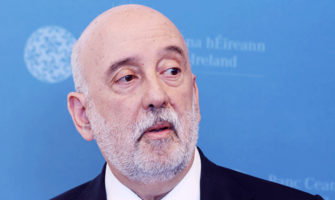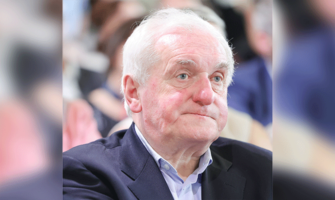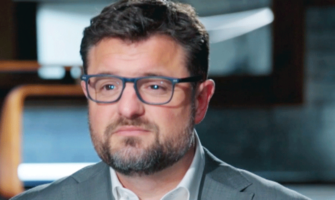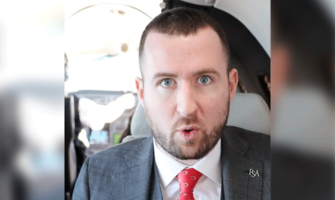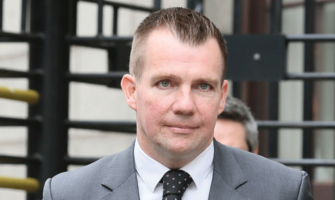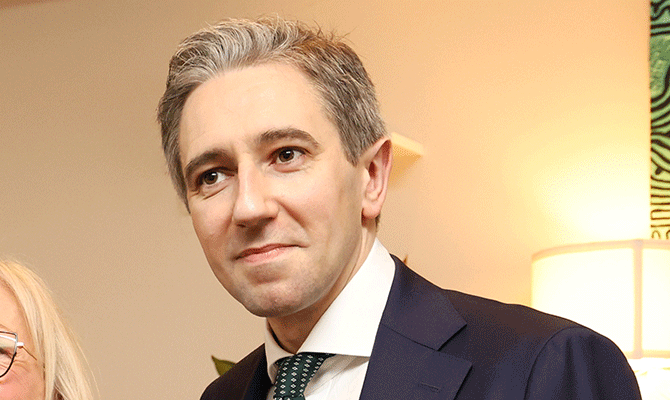
Simon Harris
HOW DID 37-year-old Simon Harris beat off heavyweight contenders Paschal Donohoe and Simon Coveney, as well as Helen McEntee and other ambitious souls, to take the Fine Gael leadership and the job of Taoiseach within 24 hours or so? Harris not only blew away these pretenders but frightened them off the pitch before the game began, thus taking the prize with a bye. But a harder question is: how will Harris avert a thrashing at the next general election, with poor poll figures and a demoralised membership that appears to be out of touch with even its own supporters?
Looking back since the formation of this coalition Government in July 2020, the wonder is that there was such a surprise at Leo Varadkar’s recent ‘shock’ resignation and the total unpreparedness of all the presumed contenders to succeed him – all bar Simon Harris, that is. It’s not as if FG’s saviour, Varadkar, looked like an unassailable leader in 2020, having led the party to a very bad general election result – down to 35 seats from 50 – followed by a blundering public spat with then chief medical officer Tony Holohan about the latter’s demand for strict anti-Covid measures. And a Garda investigation into the FG leader leaking a confidential document concerning Government negotiations with GPs was most unedifying.
Ironically, it was the pandemic that resurrected FG’s polling rates after the general election and before the formation of the coalition Government. But while Varadkar and then health minister Simon Harris also benefited personally from their apparently measured and reassuring public manner, this was not enough to protect the acting taoiseach from the other controversies. His stock declined significantly while that of Harris soared (see The Phoenix 12/3/21) in a major revival after his spell as health minister since 2016.
Only his prominent role as Minister for Health in the Repeal the 8th referendum saved Harris from the dispiriting fate of successive health ministers in this period and nobody seemed to care that he pledged to “oppose any legislation to introduce abortion in Ireland” before the 2011 general election. Another irony was that Micheál Martin insisted on taking the health department in the coalition (and housing), so confident was he that Fianna Fáil would sort out these major problems.
Instead, when Stephen Donnelly was appointed health minister in June 2020, his performance compared unfavourably with Harris’s smooth, reassuring, caring etc role dealing with Covid up until then – another PR win for Simon Harris while those around him in Cabinet floundered. As Goldhawk wrote at the time, by early 2021 Harris had become a “contender for the top job”.
Another feature of the FG Cabinet tier at this time, just over a year after the general election, was that big beasts Paschal Donohoe and Simon Coveney had shrunk to that of yesterday’s leadership contenders – Donohoe because he had been director of elections in 2020 and had failed, as finance minister, to loosen the exchequer strings before the election; Coveney because he had become boring and presumptuous in the eyes of his parliamentary party and also because, a short time later, he had blundered embarrassingly in the fiasco over the special envoy UN job-that-wasn’t-a-job for former minister Katherine Zappone in 2021.
What really underlines the shock of the body politic, including the mainstream media, when Varadkar resigned was that the evidence of the taoiseach’s political decline was plain to see more than three years ago, even if most of the highly restrained political correspondents were unable to see it or declined to write about it.
As early as February 2021, former junior minister John Paul Phelan provoked gales of laughter when, describing the efforts of Varadkar and Coveney to bluff their way through a parliamentary party meeting, he described their long-winded speechifying as “the Fine Gael equivalent of a punishment beating” (see The Phoenix 4/6/21). In time, alienating Phelan would have consequences for the party leadership.
In August 2021 Goldhawk referred to FG as rudderless under Varadkar but explained that the status of the party’s heavyweights – Coveney and Donohoe – had also declined.
A month later, word spread inside FG that Big Phil Hogan (that vengeful political brute who had been deposed from his EU Commission post with much assistance from Varadkar) was meddling in party matters – and Phil is the very last person a nervous FG leader would want to be so doing. At this stage Hogan had whispered in party circles that Heather Humphreys would be a good interim leader while waiting until the next generation of contenders matured. He later settled on Simon Harris, of course, as the man that would deal with the impertinent Varadkar, whom he had helped to become party leader in 2017.
The point here, initially, was not so much that Big Phil was selecting Heather or Simon as the next leader but that the unforgiving ex-commissioner was aware that Varadkar was most vulnerable at this early date – mid 2021.
POOL OF TALENT
In April 2022, Goldhawk referred to “mounting anger among members at all levels of the party about Varadkar’s lackadaisical leadership” and demands for a change in style, presentation and personnel. But the same article argued that the reason then tánaiste Varadkar was not facing a leadership crisis was that none of the available pretenders were regarded as either up for it or up to it. The view was that the next leader would have to come from the next generation.
With Donohoe and Coveney being edged out of the much-vaunted ‘pool of talent’ available to the party as leaders, a new dynamic – or rather, paralysis – began to assert itself, with Harris seen as not quite ready but more likely than the others to become leader; junior minister Peter Burke was highly capable but had not yet sat at the Cabinet table; and Helen McEntee was not regarded as leadership material. Meanwhile another would-be leader, Jennifer Carroll MacNeill – programme manager to three ministers – was emerging as a potential leader, although she had to wait until December 2022 to become a junior minister.
There were further squalls in the parliamentary party in 2022 and discontented ex-ministers such as Phelan (again), Charlie Flanagan (repeatedly) and Paul Kehoe expressed their criticisms with abandonment. But it was not just the demoted, disgruntled ones that were complaining – senator Martin Conway also pitched in at parliamentary party meetings.
Still, media coverage of a major political party with a failing leader and continued (if usually discreet) back-biting against him virtually ignored what looked like a real leadership crisis. Would this anaesthetised media approach have been the response had the same circumstances surrounded FF in recent years? Think Bertie Ahern, Albert Reynolds and Charlie Haughey. Or was the mainstream media so paranoid about Sinn Féin’s growth that it was afraid of destabilising the coalition?
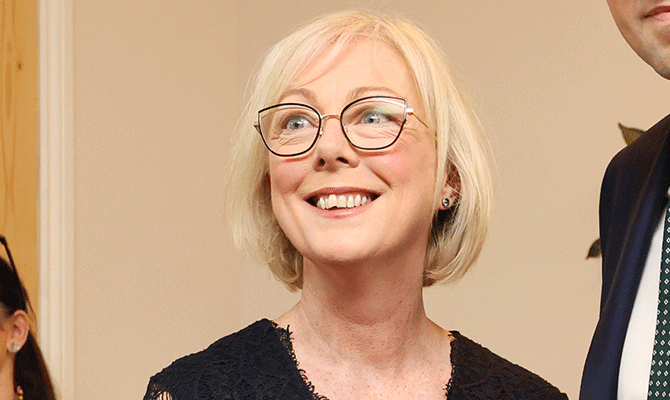
Regina Doherty
‘DONE DEAL’
Last year saw Varadkar assume his post as Taoiseach once more but it did not see any improvement in FG’s poll ratings, which have remained at around 20% on average since then. However, this period did see Simon Harris ram home his advantage on all fronts and it was noted (see The Phoenix 13/1/23) that “in recent years he has cultivated party members the length and breadth of the country”.
Four months later Goldhawk argued that the ascension of Harris as party leader was “virtually a done deal” and that he was ahead of any other contenders “by a country mile”. This view (see edition 19/5/23) was based partly on the members’ perception that, despite a high-powered PR campaign behind McEntee, she had not lived up to the image of a modern, female leader.
Her decision to go with the liberal, feminist programme did not help this campaign. Nor did the decision of her supposed mentor, Varadkar, to enlist Harris as her replacement in justice when she went on maternity leave last year, allowing her rival to create the impression that he had done more in six months in justice than she had in two-and-a-half years. Was this another example of Varadkar losing his drive and attention to political detail because of his personal crisis over the previous two years or more?
The problem for Harris in the last year was his fear of moving prematurely against the party establishment. This was in spite of the alternative fear that not moving quickly could see the emergence of new contenders such as the impressive Burke and the also impressive if over-ambitious MacNeill. Neither had any Cabinet experience but, if matters proceeded unchallenged, they might acquire such experience if FF/FG plus a third force managed to forge another coalition in the next 12 months.
If MacNeill comes over as ambitious it’s because she is, but her short period making phone calls to sound out her chances – very short given the response – was because Harris’s rise to the leadership was most unwelcome. She will know that, barring some cataclysmic event, Harris is leader for the long haul and at 43 – six years his senior – Jennifer’s chances of Cabinet membership are most uncertain given FG’s likely general election results shortly. Thus, she was the only contender to hit the phones last month in the day or so after Varadkar resigned.
One view among the victorious Harris circle was articulated by the rhetorical question: why did no one else want to be leader of this great party?
The reasons Harris won the leadership are many. They include his incredible work rate, his communications skills, and Varadkar’s personal and political implosion. But the absence of any opponent also helped.
Simon Harris did not have a super team of west wingers staffing the phones to muster support and those he did have included relative non-entities such as ex-junior ministers Colm Brophy, Paul Kehoe and Phelan (vingince, bejaysus, for the punishment beatings) and also Conway. Naturally, Big Phil is also taking some not-so-small credit for Harris’s victory, while EU candidate and former minister Regina Doherty was also instrumental in promoting his leadership before and during his 24-hour leadership blitz.
Much speculation about who will be in Harris’s Cabinet centres on one or two male politicians such as Burke and Brendan Griffin, who look likely to replace Coveney and Varadkar. But these are mere details compared to the real problem that faces Harris and FG.
McDOWELL’S ALLIANCE
Another political development neglected by the media has been the cunning plot being hatched by Michael McDowell and right-thinking (very right-thinking) colleagues. McDowell is deploying the play book designed by Shane Ross and Finian McGrath in the 2016-2020 coalition, which saw a clutch of six or so independent TDs negotiate a series of ministerial and other positions within and without Cabinet.
That Independent Alliance had the sparsest of political programmes but in 2024 McDowell knows where the political space is – somewhere between right-but-polite FG and the far-right rabble.
The latter are unlikely to take a single Dáil seat at the next election, whatever about the local elections, but McDowell is already talking to half a dozen or more sitting TDs about forming a new alliance and more will likely follow.
Harris has indicated a shift to the right for his new FG but there is only so far that he can move the relatively broad church that is his party. The Progressive Democrats were a more cohesive force in Irish politics and the comparisons with McDowell’s new group are not exact but they do exist. One of these is that the PDs inflicted much more electoral damage on FG than FF and helped to keep them out of power for years.
What can Simon Harris and a rattled FG do about McDowell other than parlay with him about coalition formation post-election?















